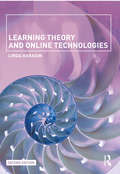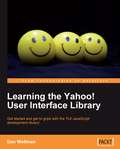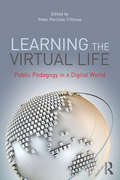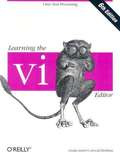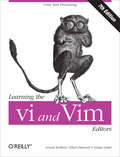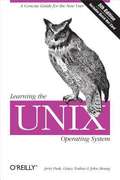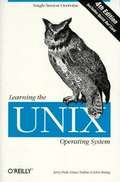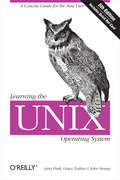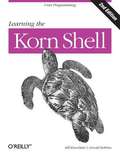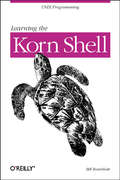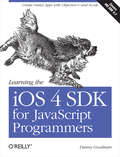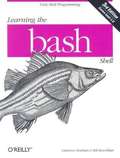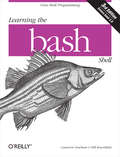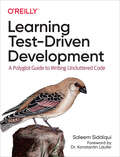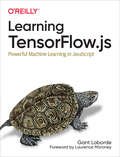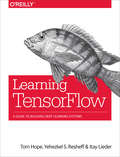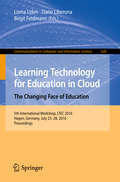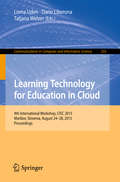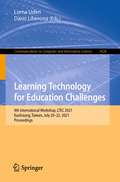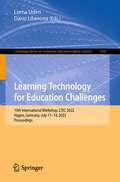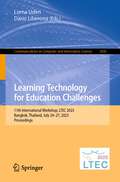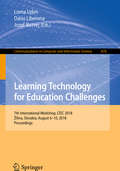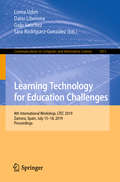- Table View
- List View
Learning Theory and Online Technologies
by Linda HarasimLearning Theory and Online Technologies offers a powerful overview of the current state of online learning, the foundations of its historical roots and growth, and a framework for distinguishing between the major approaches to online learning. It addresses pedagogy (how to design an effective online environment for learning), evaluation (how to know that students are learning), and history (how past research can guide successful online teaching and learning outcomes). An ideal textbook for undergraduate Education and Communication programs as well as Educational Technology Masters, Ph.D., and Certificate programs, Learning Theory and Online Technologies provides a synthesis of the key advances in online education learning theory and the key frameworks of research, and clearly links theory and research to successful learning practice. This revised second edition updates data on digital media adoption globally, adds a new chapter on connectivism as a learning theory, and updates the chapter on online collaborative learning, renaming the theory as collaborativism and considering the challenges that arise with the growth of artificial intelligence.
Learning the Yahoo! User Interface library
by Dan WellmanThe book is a tutorial, leading the reader first through the basics of the YUI library before moving on to more complex examples involving the YUI controls and utilities. The book is heavily example driven, and based around an approach of tinkering and extending to improve. This book is for web developers comfortable with JavaScript and CSS, who want to use the YUI library to easily put together rich, responsive web interfaces. No knowledge of the YUI library is presumed.
Learning the Virtual Life: Public Pedagogy in a Digital World
by Peter Pericles TrifonasDigital technologies have transformed cultural perceptions of learning and what it means to be literate, expanding the importance of experience alongside interpretation and reflection. Learning the Virtual Life offers ways to consider the local and global effects of digital media on educational environments, as well as the cultural transformations of how we now define learning and literacy. While some have welcomed the educational challenges of digital culture and emphasized its possibilities for individual emancipation and social transformation in the new information age, others accuse digital culture of absorbing its recipients in an all-pervasive virtual world. Unlike most accounts of the educational and cultural consequences of digital culture, Learning the Virtual Life presents a neutral, advanced introduction to the key issues involved with the integration of digital culture and education. This edited collection presents international perspectives on a wide range of issues, and each chapter combines upper-level theory with "real-world" practice, making this essential reading for all those interested in digital media and education.
Learning the vi Editor, Sixth Edition
by Linda Lamb Arnold RobbinsThis completely updated guide to editing with vi, the editor available on nearly every Unix system, now covers four popular viclones and includes command summaries for easy reference. It starts with the basics, followed by more advanced editing tools, such as ex commands, global search and replacement, and a new feature, multiscreen editing.
Learning the vi and Vim Editors: Text Processing at Maximum Speed and Power
by Linda Lamb Arnold Robbins Elbert HannahThere's nothing that hard-core Unix and Linux users are more fanatical about than their text editor. Editors are the subject of adoration and worship, or of scorn and ridicule, depending upon whether the topic of discussion is your editor or someone else's. vi has been the standard editor for close to 30 years. Popular on Unix and Linux, it has a growing following on Windows systems, too. Most experienced system administrators cite vi as their tool of choice. And since 1986, this book has been the guide for vi. However, Unix systems are not what they were 30 years ago, and neither is this book. While retaining all the valuable features of previous editions, the 7th edition of Learning the vi and vim Editors has been expanded to include detailed information on vim, the leading vi clone. vim is the default version of vi on most Linux systems and on Mac OS X, and is available for many other operating systems too. With this guide, you learn text editing basics and advanced tools for both editors, such as multi-window editing, how to write both interactive macros and scripts to extend the editor, and power tools for programmers -- all in the easy-to-follow style that has made this book a classic.Learning the vi and vim Editors includes:A complete introduction to text editing with vi: How to move around vi in a hurry Beyond the basics, such as using buffers vi's global search and replacement Advanced editing, including customizing vi and executing Unix commandsHow to make full use of vim: Extended text objects and more powerful regular expressions Multi-window editing and powerful vim scripts How to make full use of the GUI version of vim, called gvim vim's enhancements for programmers, such as syntax highlighting, folding and extended tags Coverage of three other popular vi clones -- nvi, elvis, and vile -- is also included. You'll find several valuable appendixes, including an alphabetical quick reference to both vi and ex mode commands for regular vi and for vim, plus an updated appendix on vi and the Internet. Learning either vi or vim is required knowledge if you use Linux or Unix, and in either case, reading this book is essential. After reading this book, the choice of editor will be obvious for you too.
Learning the Unix Operating System, 5th Edition
by Jerry Peek John Strang Grace Todino-GonguetIf you're new to Unix, this concise book will tell you just what you need to get started and no more. This fifth edition is the most effective introduction to Unix in print, covering Internet usage for email, file transfers, and web browsing. It's an ideal primer for Mac and PC users who need to know a little about Unix on the systems they visit.
Learning the UNIX Operating System, 4th Edition
by Grace Todino-Gonguet John Strang Jerry PeekIf you are new to UNIX, this concise introduction will tell you just what you need to get started and no more. Why wade through a 600-page book when you can begin working productively in a matter of minutes? It's an ideal primer for Mac and PC users of the Internet who need to know a little bit about UNIX on the systems they visit. This book is the most effective introduction to UNIX in print. The fourth edition covers the highlights of the Linux operating system. It's a handy book for someone just starting with UNIX or Linux, as well as someone who encounters a UNIX system on the Internet. And it now includes a quick-reference card. Topics covered include: Linux operating system highlights Logging in and logging out Window systems (especially X/Motif) Managing UNIX files and directories Sending and receiving mail Redirecting input/output Pipes and filters Background processing Basic network commandsv
Learning the Unix Operating System: A Concise Guide for the New User
by Jerry Peek John Strang Grace TodinoIf you are new to Unix, this concise book will tell you just what you need to get started and no more. Unix was one of the first operating systems written in C, a high-level programming language, and its natural portability and low price made it a popular choice among universities. Initially, two main dialects of Unix existed: one produced by AT&T known as System V, and one developed at UC Berkeley and known as BSD. In recent years, many other dialects have been created, including the highly popular Linux operating system and the new Mac OS X (a derivative of BSD). Learning the Unix Operating System is a handy book for someone just starting with Unix or Linux, and it's an ideal primer for Mac and PC users of the Internet who need to know a little about Unix on the systems they visit. The fifth edition is the most effective introduction to Unix in print, covering Internet usage for email, file transfers, web browsing, and many major and minor updates to help the reader navigate the ever-expanding capabilities of the operating system: In response to the popularity of Linux, the book now focuses on the popular bash shell preferred by most Linux users. Since the release of the fourth edition, the Internet and its many functions has become part of most computer user's lives. A new chapter explains how to use ftp, pine for mail, and offers useful knowledge on how to surf the web. Today everyone is concerned about security. With this in mind, the author has included tips throughout the text on security basics, especially in the Internet and networking sections. The book includes a completely updated quick reference card to make it easier for the reader to access the key functions of the command line.
Learning the Korn Shell, 2nd Edition
by Arnold Robbins Bill RosenblattLearning the Korn Shell is the key to gaining control of the Korn shell and becoming adept at using it as an interactive command and scripting language. Readers will learn how to write many applications more easily and quickly than with other high-level languages. A solid offering for many years, this newly revised title inherits a long tradition of trust among computer professionals who want to learn or refine an essential skill.
Learning the Korn Shell
by Bill RosenblattThis Nutshell Handbook(R) is a thorough introduction to the Korn shell, both as a user interface and as a programming language. The Korn shell, like the C and Bourne shells, is a program that interprets UNIX commands. It has many features that aren't found in other shells, including command history (the ability to recall and edit previous commands). The Korn shell is also faster; several of its features allow you to write programs that execute more quickly than their Bourne or C shell equivalents. This book provides a clear and concise explanation of the Korn shell's features. It explains ksh string operations, co-processes, signals and signal handling, and one of the worst "dark corners" of shell programming: command-line interpretation. It does this by introducing simple real-life examples and then adding options and complexity in later chapters, illustrating the way real-world script development generally proceeds. An additional (and unique) programming aid, a Korn shell debugger ( kshdb ), is also included. Learning the Korn Shell is an ideal resource for many UNIX users and programmers, including software developers who want to "prototype" their designs, system administrators who want to write tools for their own use, and even novices who just want to use some of ksh's more advanced interactive features.
Learning the Korn Shell
by Bill Rosenblatt Arnold RobbinsThe Korn shell is an interactive command and scripting language for accessing Unix® and other computer systems. As a complete and high-level programming language in itself, it's been a favorite since it was developed in the mid 1980s by David G. Korn at AT&T Bell Laboratories. Knowing how to use it is an essential skill for serious Unix users. Learning the Korn Shell shows you how to use the Korn shell as a user interface and as a programming environment. Writing applications is often easier and quicker with Korn than with other high-level languages. Because of this, the Korn shell is the most often used shell in commercial environments and among inexperienced users. There are two other widely used shells, the Bourne shell and the C shell. The Korn shell, or ksh, has the best features of both, plus many new features of its own. ksh can do much to enhance productivity and the quality of a user's work, both in interacting with the system, and in programming. The new version, ksh93, has the functionality of other scripting languages such as awk, icon, Perl, rexx, and tcl. Learning the Korn Shell is the key to gaining control of the Korn shell and becoming adept at using it as an interactive command and scripting language. Prior programming experience is not required in order to understand the chapters on basic shell programming. Readers will learn how to write many applications more easily and quickly than with other high-level languages. In addition, readers will also learn about Unix utilities and the way the Unix operating system works in general. The authors maintain that you shouldn't have to be an internals expert to use and program the shell effectively. The second edition covers all the features of the current version of the Korn shell, including many new features not in earlier versions of ksh93, making it the most up-to-date reference available on the Korn shell. It compares the current version of the Korn shell to several other Bourne-compatible shells, including several Unix emulation environments for MS-DOS and Windows. In addition, it describes how to download and build ksh93 from source code. A solid offering for many years, this newly revised title inherits a long tradition of trust among computer professionals who want to learn or refine an essential skill.
Learning the iOS 4 SDK for JavaScript Programmers: Create Native Apps with Objective-C and Xcode
by Danny GoodmanIs it possible for JavaScript programmers to learn Apple's iOS 4 SDK and live to tell the tale? Technology guru Danny Goodman did, and with this book he leaves a well-marked trail for you to follow. An authority on JavaScript since its inception, Goodman understands the challenges you might face in creating native iOS apps with this SDK, and introduces Xcode, Objective-C, and Cocoa Touch in a context you'll readily understand. Why bother with the SDK when you can simply build web apps for Apple's iOS devices? Web apps can't access an iPhone's music library, camera, or iOS system software for maps, audio, and more. Nor can you sell web apps in the App Store. If you want to take full advantage of the iPhone and iPad, iOS 4 SDK is your tool -- and this is your book. Includes full coverage of iOS SDK 4.2. Learn the distinction between web app and iOS native app programming Create a workbench app to test code snippets throughout the learning process Get a structural view of an iOS app, and compare the process of building objects in Objective-C versus JavaScipt Discover how your code launches iOS apps and makes them user-ready Learn about iOS memory management details that are different from JavaScript, including pointers and data types Use Objective-C and Cocoa Touch to implement common JavaScript tasks
Learning the bash Shell, Second Edition
by Cameron Newham Bill RosenblattThis second edition covers all of the features of bash Version 2.0, while still applying to bash Version 1.x. It includes one-dimensional arrays, parameter expansion, more pattern-matching operations, new commands, security improvements, additions to ReadLine, improved configuration and installation, and an additional programming aid, the bash shell debugger.
Learning the bash Shell, 3rd Edition
by Cameron NewhamThis refreshed edition serves as the most valuable guide yet to the bash shell. It's full of practical examples of shell commands and programs guaranteed to make everyday use of Linux that much easier. Includes information on key bindings, command line editing and processing, integrated programming features, signal handling, and much more!
Learning the bash Shell
by Cameron NewhamO'Reilly's bestselling book on Linux's bash shell is at it again. Now that Linux is an established player both as a server and on the desktop Learning the bash Shell has been updated and refreshed to account for all the latest changes. Indeed, this third edition serves as the most valuable guide yet to the bash shell. As any good programmer knows, the first thing users of the Linux operating system come face to face with is the shell the UNIX term for a user interface to the system. In other words, it's what lets you communicate with the computer via the keyboard and display. Mastering the bash shell might sound fairly simple but it isn't. In truth, there are many complexities that need careful explanation, which is just what Learning the bash Shell provides. If you are new to shell programming, the book provides an excellent introduction, covering everything from the most basic to the most advanced features. And if you've been writing shell scripts for years, it offers a great way to find out what the new shell offers. Learning the bash Shell is also full of practical examples of shell commands and programs that will make everyday use of Linux that much easier. With this book, programmers will learn: How to install bash as your login shell The basics of interactive shell use, including UNIX file and directory structures, standard I/O, and background jobs Command line editing, history substitution, and key bindingsHow to customize your shell environment without programmingThe nuts and bolts of basic shell programming, flow control structures, command-line options and typed variablesProcess handling, from job control to processes, coroutines and subshellsDebugging techniques, such as trace and verbose modesTechniques for implementing system-wide shell customization and features related to system security
Learning Test-Driven Development: A Polyglot Guide To Writing Uncluttered Code
by Saleem SiddiquiYour code is a testament to your skills as a developer. No matter what language you use, code should be clean, elegant, and uncluttered. By using test-driven development (TDD), you'll write code that's easy to understand, retains its elegance, and works for months, even years, to come. With this indispensable guide, you'll learn how to use TDD with three different languages: Go, JavaScript, and Python.Author Saleem Siddiqui shows you how to tackle domain complexity using a unit test-driven approach. TDD partitions requirements into small, implementable features, enabling you to solve problems irrespective of the languages and frameworks you use. With Learning Test-Driven Development at your side, you'll learn how to incorporate TDD into your regular coding practice.This book helps you:Use TDD's divide-and-conquer approach to tame domain complexityUnderstand how TDD works across languages, testing frameworks, and domain conceptsLearn how TDD enables continuous integrationSupport refactoring and redesign with TDDLearn how to write a simple and effective unit test harness in JavaScriptSet up a continuous integration environment with the unit tests produced during TDDWrite clean, uncluttered code using TDD in Go, JavaScript, and Python
Learning TensorFlow.js: Powerful Machine Learning In Javascript
by Gant LabordeGiven the demand for AI and the ubiquity of JavaScript, TensorFlow.js was inevitable. With this Google framework, seasoned AI veterans and web developers alike can help propel the future of AI-driven websites. In this guide, author Gant Laborde--Google Developer Expert in machine learningand the web--provides a hands-on end-to-end approach to TensorFlow.js fundamentals for a broad technical audience that includes data scientists, engineers, web developers, students, and researchers.You'll begin by working through some basic examples in TensorFlow.js before diving deeper into neural network architectures, DataFrames, TensorFlow Hub, model conversion, transfer learning, and more. Once you finish this book, you'll know how to build and deploy production-readydeep learning systems with TensorFlow.js.Explore tensors, the most fundamental structure of machine learningConvert data into tensors and back with a real-world exampleCombine AI with the web using TensorFlow.jsUse resources to convert, train, and manage machine learning dataBuild and train your own training models from scratch
Learning TensorFlow: A Guide to Building Deep Learning Systems
by Itay Lieder Tom Hope Yehezkel S. ResheffRoughly inspired by the human brain, deep neural networks trained with large amounts of data can solve complex tasks with unprecedented accuracy. This practical book provides an end-to-end guide to TensorFlow, the leading open source software library that helps you build and train neural networks for computer vision, natural language processing (NLP), speech recognition, and general predictive analytics.Authors Tom Hope, Yehezkel Resheff, and Itay Lieder provide a hands-on approach to TensorFlow fundamentals for a broad technical audience—from data scientists and engineers to students and researchers. You’ll begin by working through some basic examples in TensorFlow before diving deeper into topics such as neural network architectures, TensorBoard visualization, TensorFlow abstraction libraries, and multithreaded input pipelines. Once you finish this book, you’ll know how to build and deploy production-ready deep learning systems in TensorFlow.Get up and running with TensorFlow, rapidly and painlesslyLearn how to use TensorFlow to build deep learning models from the ground upTrain popular deep learning models for computer vision and NLPUse extensive abstraction libraries to make development easier and fasterLearn how to scale TensorFlow, and use clusters to distribute model trainingDeploy TensorFlow in a production setting
Learning Technology for Education in Cloud - The Changing Face of Education
by Lorna Uden Dario Liberona Birgit FeldmannThis book constitutes the refereed proceedings of the 5th International Workshop on Learning Technology for Education in Cloud, LTEC 2016, held in Maribor, Slovenia, in July 2016. The 25 revised full papers presented were carefully reviewed and selected from 51 submissions. The papers are organized in topical sections on learning technologies; learning tools and environment; MOOC for learning; problem solving and knowledge transfer; case study.
Learning Technology for Education in Cloud
by Lorna Uden Dario Liberona Tatjana WelzerThis book constitutes the refereed proceedings of the Fourth International Workshop on Learning Technology for Education in Cloud, LTEC 2015, held in Maribor, Slovenia, in August 2015. The 24 revised full papers presented were carefully reviewed and selected from 46 submissions. The papers cover various aspects of technologies for learning, such as MOOC challenges; cooperative learning; learning engineering; learning tools and environments; STEM.
Learning Technology for Education Challenges: 9th International Workshop, LTEC 2021, Kaohsiung, Taiwan, July 20-22, 2021, Proceedings (Communications in Computer and Information Science #1428)
by Lorna Uden Dario LiberonaThis book constitutes the refereed proceedings of the 9th International Workshop on Learning Technology for Education Challenges, LTEC 2021, held in Kaohsiung, Taiwan, in July 2021. The 11 revised full papers and 6 short papers presented were carefully reviewed and selected from 83 submissions. The papers are organized in the following topical sections: learning tools and environment; e-learning and transferability strategies; serious games technologies; learning practices and knowledge transfer.
Learning Technology for Education Challenges: 10th International Workshop, LTEC 2022, Hagen, Germany, July 11–14, 2022, Proceedings (Communications in Computer and Information Science #1595)
by Lorna Uden Dario LiberonaThis book constitutes the refereed proceedings of the 10th International Workshop on Learning Technology for Education Challenges, LTEC 2022, held in Hagen, Germany, in July 2022. The 14 revised full papers and 6 short papers presented were carefully reviewed and selected from 41 submissions. The papers are organized in the following topical sections: learning methodologies and pandemic impact; learning practices and methodologies; learning technologies; learning technologies performance; serious games and virtual learning environments.
Learning Technology for Education Challenges: 11th International Workshop, LTEC 2023, Bangkok, Thailand, July 24–27, 2023, Proceedings (Communications in Computer and Information Science #1830)
by Lorna Uden Dario LiberonaThis book constitutes the refereed proceedings of the International Workshop on Learning Technology for Education Challenges, LTEC 2023, held in Bangkok, Thailand, during July 24–27, 2023.The 27 full papers included in this book were carefully reviewed and selected from 53 submissions. They were organized in topical sections as follows: serious games and virtual learning environments; learning practices and methodologies; learning technologies; learning mehtodologies and models; learning technologies performance.
Learning Technology for Education Challenges: 7th International Workshop, LTEC 2018, Žilina, Slovakia, August 6–10, 2018, Proceedings (Communications in Computer and Information Science #870)
by Lorna Uden Dario Liberona Jozef RistvejThis book constitutes the refereed proceedings of the 7th International Workshop on Learning Technology for Education Challenges, LTEC 2018, held in Žilina, Slovakia, in August 2018. The 25 revised full papers presented were carefully reviewed and selected from 54 submissions. The papers are organized in the following topical sections: Gamification and learning; learning and knowledge transfer; learning technologies applications; virtual learning environments; and mobile learning and MOOCs. LTEC 2018 examines how these technologies and pedagogical advances can be used to change the way teachers teach and students learn, while giving special emphasis to the pedagogically effective ways we can harness these new technologies in education.
Learning Technology for Education Challenges: 8th International Workshop, LTEC 2019, Zamora, Spain, July 15–18, 2019, Proceedings (Communications in Computer and Information Science #1011)
by Lorna Uden Dario Liberona Galo Sanchez Sara Rodríguez-GonzálezThis book constitutes the refereed proceedings of the 8th International Workshop on Learning Technology for Education Challenges, LTEC 2019, held in Zamora, Spain, in July 2019.The 41 revised full papers presented were carefully reviewed and selected from 83 submissions. The papers are organized in the following topical sections: learning technolgies; learning tools and environment; e-learning and MOOCs; learning practices; social media learning tools; machine learning and evaluation support programs. LTEC 2019 examines how these technologies and pedagogical advances can be used to change the way teachers teach and students learn, while giving special emphasis to the pedagogically effective ways we can harness these new technologies in education.
